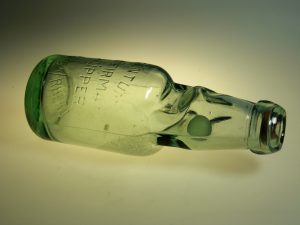Flaschen: Klickerflasche – Deutsch/German

„Die Bengels haben uns immer die Flaschen geklaut und kaputt gehauen, da musste man achtgeben …“, beschwerte sich einst ein Getränkeabfüller. Abgesehen hatten es die „Bengels“ auf die Glasmurmeln in den Knicker- oder Klickerflaschen. Deren Tauschkurs lag laut eines Zeitzeugen bei 50 Tonmurmeln. Knicker- oder Klickerflaschen waren verbreitet während der „Büdchen“- oder Trinkhallen-Kultur von 1880 bis in die 1950er Jahre vor allem in den Städten des Ruhrgebiets.
Mithilfe einer Glasmurmel war es möglich Flaschen luftdicht zu verschließen. Dies war besonders wichtig aufgrund der gerade aufkommenden kohlensäurehaltigen Mineralwässer. Bei den noch üblichen Steingutflaschen entwich das Gas und aus den einfachen Glasflaschen flogen die Korken heraus. Die Glasmurmel dagegen wurde durch den Gasinnendruck der Kohlensäure unter einen Gummiring gepresst und schloss somit die Flasche luftdicht ab.
Zum Öffnen der Flasche musste die Murmel mittels eines Fingers oder Holzstabes zurück in die Flasche gedrückt werden. Dort fand sie im „eingeschnürten“ Flaschenhals Halt. Der Inhalt konnte ausgegossen werden, ohne dass die Murmel die Halsöffnung verschloss.
Bottles: Codd-Neck Bottle – English

„The urchins always stole our bottles and smashed them to pieces, you had to watch out …“, complained a drink filler once. The urchins were keen on the glass marbles in the codd-neck bottles. According to a contemporary witness the exchange rate was 1 to 50 clay marbles. The German equivalent of Codd-Neck Bottles became popular during the period of the kiosk or refreshment stand culture from 1880 until into the 1950s in above all, towns in the Ruhr region.
The glass marble made it possible to create an airtight seal in the bottles, which was extremely important in the face of the emerging trend for carbonated mineral water. The gas leaked out of the usual stoneware bottles and the cork flew out of simple glass bottles. The pressure of the gas in the carbonated liquid on the other hand pressed the marble against a rubber ring, which closed the bottle and made it airtight.
To open the bottle, the marble had to be pushed back into it with a finger or piece of wood, where it caught in the constricted bottleneck. The contents could then be poured out without the marble closing the opening.